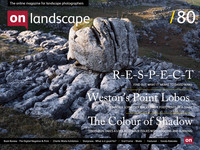Looking at our Hard Wired Response to Landscape
When we view any landscape scene, there is some form of emotional response. This article is about the fundamental origins of these reactions – why elements of a captivating landscape photograph such as compositional features, environmental conditions and lighting situations trigger human emotion.
Evolutionary psychology attempts to explain why our interpretations and reactions are, to a large extent, universal among modern humans.1 Why, for instance, does an expansive view with a clear focal point, areas of high contrast and a strong foreground element look pleasant to us? In the following text, I hope to demonstrate how many of the answers lie in the study of our evolution as Pleistocene hunter-gatherers.
The Landscape and Animal Emotion
Much like any other component of an animal's body, emotions are ultimately tools to ensure the survival and replication of genes. Over time, advantageous traits that arise within a population become universal through the process of natural selection, leading to highly adapted bodies and minds able to operate more efficiently – and therefore with greater reproductive success – within their environment. Fundamentally these adaptations define separate species.
Featured Comments From:
Adam Long: Great piece Jordan, fascinating. You’ve expanded greatly on a phrase that has stuck with me for twenty years since studying A-level biology; that ‘given the choice, man prefers to settle on an open grassy plain, with groups of trees and rock outcrops’. It has informed my photography ever since and I’ve always meant to research it further, but never got round to it. I look forward to getting stuck into that reading list now, many thanks!
Roger Voller: Thanks for putting some light on how a desirable landscape photograph is shaped. Our busy lives are spent knowing what we like but not thinking about why we like. My subconscious mind selects what composition I frame but now I can demonstrate a bit more intelligence why I selected it :)


